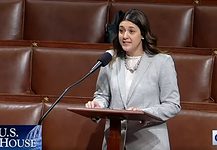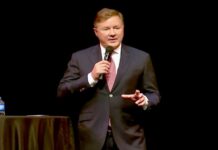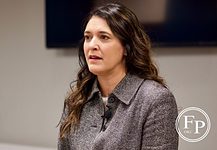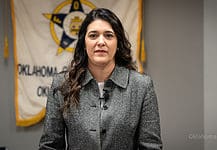Last Updated on February 3, 2021, 8:44 PM | Published: February 3, 2021
One of the most predictable but tragic outcomes of remote learning during the COVID-19 pandemic is that some students fell through the cracks. If a student lacks access to high-speed internet or does not have a structure in place at home to ensure online attendance for months on end, they are likely to drift away.
During Monday’s State of the State address to the Oklahoma Legislature, Stitt decried the fact that the state’s public schools’ student count now includes 55,000 “ghost students” — students who went missing from online classes so far during the pandemic.
He now wants to eliminate funding for teaching those students as a cost-saving initiative rather than accounting for them. They are essentially “in the wind,” an unforeseen crisis among many, and Stitt only sees opportunity.
Opinion by George D. Lang
“Right now, we have the opportunity of a lifetime. We have a chance to rethink and reimagine the future of education in Oklahoma,” said Gov. Kevin Stitt during Monday’s State of the State address to the Oklahoma Legislature. “One of the ways we can do this is by looking at how schools get their funding. The current formula lets schools pick their highest number of students over the last three years.
“Here’s what that means: Say you lived in Tulsa and moved to a new district to make sure your kids could go to school in person. Your kids could be counted by both districts. They’re called ‘ghost students.’ This is unacceptable. It’s time for schools to be funded based on how many students they have now — not how many they had in the past.”
Courtesy of the anti-public-schools Oklahoma Council of Public Affairs, “ghost students” is actually repurposed terminology.
According to Jennifer Palmer of Oklahoma Watch, “ghost students” originally referred to Epic Charter Schools’ practice of enrolling students who were not attending Epic to boost enrollment numbers. They were like Mafia “no-show jobs,” or when Wells Fargo issued fake accounts and loans to inflate its bottom line.
Stitt appears to be arguing that COVID-19 and the subsequent loss of thousands of students is an opportunity to reduce public school funding.
“There are more than 55,000 ‘ghost students’ in our funding formula right now,” Stitt said. “That means we’re allocating close to 200 million of your tax dollars to students who don’t exist.”
The problem is that they do exist. They are still out there. But, they are lost to our schools right now.
It should be a priority for every public school to re-enfranchise students who stopped going to school once the pandemic hit.
Instead of possessing a passion for finding lost students, Stitt wants to reduce funding for public schools to permanently weaken them.
And, while he was at it, why not slap around one of the two most urbanized public school districts in the state that has large societal problems to surmount?
Stitt had particularly harsh words for Tulsa Public Schools for continuing remote learning while many of the exurban cities surrounding it were being comparatively free and easy with a disease that claimed more than 1,000 Oklahomans in January.
“It’s now been 325 days since Tulsa students in 4th through 12th grades have been allowed to be in their classrooms. 325 days!” he said. “Meanwhile, just a few blocks away, the rest of the Tulsa metro has been safely in session most of the year. Union, Jenks, Broken Arrow, Bixby, Owasso, Sapulpa, Sand Springs, Sperry, Skiatook, Collinsville. The list goes on. They’ve all found ways to put their students first and give them the choice to come back to the classroom.”
In response to Stitt’s callout in the State of the State address, TPS superintendent Dr. Deborah Gist wrote a lengthy post on Facebook that stated her position on the return to in-person learning. She also criticized Stitt’s response to COVID-19, including his recently announced policy to not require COVID-positive students to isolate at home as long as their classmates were masked and socially distanced.
“Unfortunately, sometimes bullies double down on their behavior particularly if they have a target they enjoy or one that is getting them the attention they desire,” Gist wrote. “That is, sadly, what our governor did. Sometimes when a bully backs you into a corner, you have to defend yourself despite what you would prefer to do.”
“We live in a state that has had one of the highest COVID rates in the entire world,” she continued. “Our governor has done very little to address that and has, in fact, behaved in ways that exacerbated the work of health professionals. Now, rather than owning that situation and focusing on the efforts to address it, he wants to point in our direction. He is preying on the very real and understandable fear, frustration, and anger of our families and deflecting from what he has done to cause the situation.
“After ignoring the advice of the Trump White House Task Force and even hiding their feedback until it was too late, he spends precious time creating drama rather than solving problems. That is not what a good leader does,” Gist wrote.
Stitt’s policies implicitly suggest there is an acceptable rate of death as long as students can return to schools. Gist and TPS now face possible budget cuts because they erred on the side of epidemiologists and the concerns of parents and kept students at home.
Politicizing COVID-19 as a wedge issue against political rivals is a zero-sum game. In the effort to combat the so-called phenomenon of “ghost students,” we should not risk the possibility of our children and our neighbors actually requiring headstones. We must let the vaccines roll out and their benefits take hold before we force in-person learning.
In another time, doing so would be considered “conservative.”
George Lang has worked as an award-winning professional journalist in Oklahoma City for over 25 years and is the professional opinion columnist for Free Press. His work has been published in a number of local publications covering a wide range of subjects including politics, media, entertainment and others. George lives in Oklahoma City with his wife and son.











